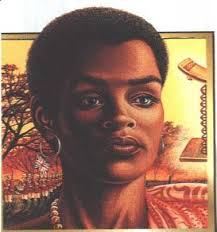|
Yaa Asantewaa was born in 1840 in the Ejisu-Juaben Municipal District, Ghana. She is widely known for leading the Ashante Rebellion against British colonialism. Yaa was appointed Queen Mother by her brother Nana Akwasi the ruler of Ejisu, an ethnic group in present day Ghana. Akwasi died after a civil war in Ghana in 1888, after his death Yaa Asantewaa used her influence to nominate her grandson as the ruler of Ejisu. In 1896, her grandson as well as the King of the Ashante (Premph I) were exiled to Seychelles by the British. The British often used this tactic to weaken the people they wanted to dominate. They repeatedly looted the lands of the exiled Kings, this lead to the discoveries of a lot of Africa’s valued arts and crafts in the British Museums. To this day Africa has been unable to recover its stolen art. To add insult to injury the arrogant British Governor-General of Ghana Fredrick Hodgson, demanded the sacred Golden Stool of the Ashante. That Stool is an important symbol of the Ashante Nation; this prompted a meeting of the elders of Ejisu. At this meeting the Chiefs were discussing going to war with the British, forcing them to bring back the Ashanteehene King (Nana) Premhp I. Yaa noticed that a great number of the chiefs were afraid, some rejected the idea of war, they proposed going to the Governor and begging him to bring back the King. With the greatest passion Yaa Asantewaa stood and spoke; “Now I have seen that some of you fear to go forward to fight for our king. If it were in the brave days Osei Tutu, Okomfo Anokye, and Opoku Ware, chiefs would not sit down to see their king taken away without firing a shot. No white man could have dared to speak to chief of the Ashante in the way the Governor spoke to you chiefs this morning. Is it true that the bravery of the Ashante is no more? I cannot believe it. It cannot be! I must say this: if you the men of Ashanti will not go forward, then we will. We the women will. I shall call upon my fellow women. We will fight the white men. We will fight till the last of us falls in the battlefields.” Inspired by her speech the men were fueled for battle. In 1900 the famous uprising broke out and for months they fought bravely and kept the British at bay in their fort. Outnumbered by British troops numbering 1,400 soldiers at Kumasi, Yaa was captured and sent into exile along with the other leaders. Yaa eventually died in exile on October 17th, 1921. Her uprising against the British was Africa’s last major revolt led by a woman. Her body was later returned to Ghana and given a proper burial; to this day she is still honored. The Yaa Asantewaa Girl’s Secondary School was constructed in her name. She was the epitome of a leader, a great symbol of strength and womanhood. She gave herself to free her people and fought in the face of oppression, even when the men around her were afraid. Yaa Asantewaa, we stand on your shoulders. J.A. Ward. Click below to view the Yaa Asantewaa video
0 Comments
Leave a Reply. |
Details
Categories
All
Click Here to join our mailing list
|
Contact Us: |
Connect With Us |
Site powered by PIT Web Design


 RSS Feed
RSS Feed



